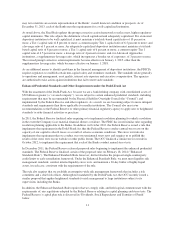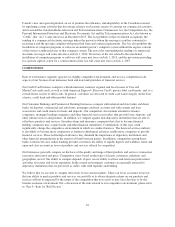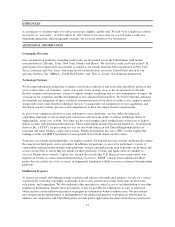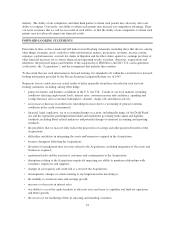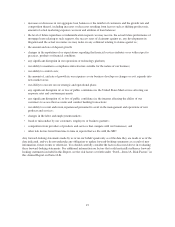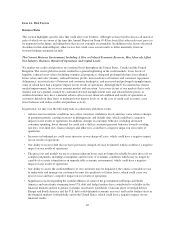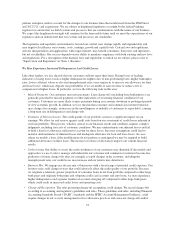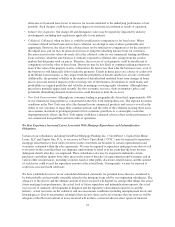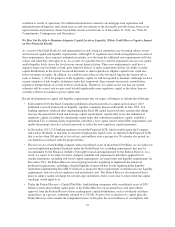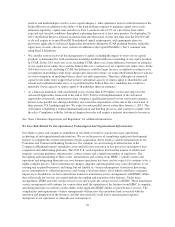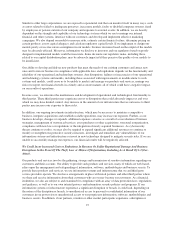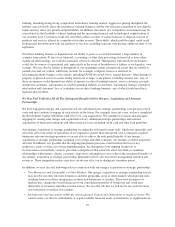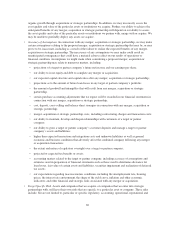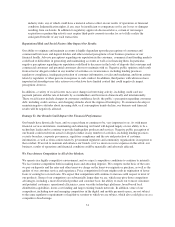Capital One 2013 Annual Report Download - page 41
Download and view the complete annual report
Please find page 41 of the 2013 Capital One annual report below. You can navigate through the pages in the report by either clicking on the pages listed below, or by using the keyword search tool below to find specific information within the annual report.• Significant concern exists regarding risks associated with the normalization of global central bank policies.
In particular, steps taken by the Federal Reserve to slow the pace of its balance sheet growth has resulted in
significant financial market volatility. This change in Federal Reserve policy, coupled with similar actions
by other central banks, has impacted economies globally, including the United States. These changes have
particularly impacted certain emerging markets in countries whose growth prospects and currency
valuations have proven vulnerable to normalization in the accommodative global central bank policies that
have prevailed in recent years. The resulting financial market volatility and greater economic uncertainty
worldwide could threaten the economic recoveries both globally and in the United States, which could have
a negative impact on our financial results.
• Our ability to borrow from other financial institutions or to engage in funding transactions on favorable
terms or at all could be adversely affected by disruptions in the capital markets or other events, including
actions by rating agencies and deteriorating investor expectations, which could limit our access to funding.
The interest rates that we pay on our securities are also influenced by, among other things, applicable credit
ratings from recognized rating agencies. A downgrade to any of these credit ratings could affect our ability
to access the capital markets, increase our borrowing costs and have a negative impact on our results of
operations. Increased charge-offs, rising London Interbank Offering Rate (“LIBOR”) and other events may
cause our securitization transactions to amortize earlier than scheduled, which could accelerate our need for
additional funding from other sources.
• An inability to accept or maintain deposits or to obtain other sources of funding could materially affect our
liquidity position and our ability to fund our business. Many other financial institutions have also increased
their reliance on deposit funding and, as such, we expect continued competition in the deposit markets. We
cannot predict how this competition will affect our costs. If we are required to offer higher interest rates to
attract or maintain deposits, our funding costs will be adversely impacted.
• Shorter-term interest rates have remained at historically low levels for a prolonged period of time. While
longer-term interest rates have recently increased resulting in a steeper yield curve, they remain below
historical averages. A flat yield curve combined with low interest rates generally leads to lower revenue and
reduced margins because it would limit our opportunity to increase the spread between asset yields and
funding costs. Any reversion to a flat yield curve coupled with low interest rates for a sustained period of
time could have a material adverse effect on our earnings and our net interest margin.
• The low interest rate environment also increases our exposure to prepayment risk in our mortgage portfolio
and the mortgage-backed securities in our investment portfolio. Increased prepayments, refinancing or other
factors that impact loan balances would reduce expected revenue associated with mortgage assets and could
also lead to a reduction in the value of our mortgage servicing rights, which could have a negative impact on
our financial results.
Compliance With New And Existing Laws, Regulations And Regulatory Expectations May Increase Our
Costs, Reduce Our Revenue, Limit Our Ability To Pursue Business Opportunities, And Increase Compliance
Challenges.
There has been increased legislation and regulation with respect to the financial services industry in the last few
years, and we expect that oversight of our business will continue to expand in scope and complexity. A wide and
increasing array of banking and consumer lending laws apply to almost every aspect of our business. Failure to
comply with these laws and regulations could result in financial, structural and operational penalties, including
receivership, and could result in negative publicity or damage to our reputation with regulators or the public. In
addition, establishing systems and processes to achieve compliance with these laws and regulations may increase
our costs and limit our ability to pursue certain business opportunities.
As a result of our large number of consumer accounts and because we have historically experienced higher
delinquencies and a greater number of accounts charging off compared to our large bank peers, we face the risk
of a heightened level of regulatory scrutiny with respect to our consumer products and services.
21


